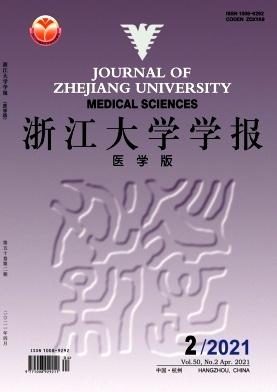Thrombus composition and regulatory T cell expression are associated with clinical outcomes in acute ischemic stroke patients with thrombectomy.
Q2 Medicine
Zhejiang da xue xue bao. Yi xue ban = Journal of Zhejiang University. Medical sciences
Pub Date : 2024-04-12
DOI:10.3724/zdxbyxb-2023-0424
引用次数: 0
Abstract
OBJECTIVES To analyze the relationship between thrombus composition and regulatory T cell expression with clinical outcome in acute ischemic stroke (AIS) patients with thrombectomy. METHODS We consecutively enrolled AIS patients with thrombectomy in the Department of Neurology, Shaoxing Hospital of China Medical University from June 2021 to October 2022. All thrombus specimens were subjected to hematoxylin-eosin staining and immunohistochemistry. Semi-quantitative analysis was performed to determine the content of red blood cells, fibrinogen/platelets, and regulatory T cells. Clinical data, vascular recanalization status, and neurologic outcomes at 3 months were collected. A modified Rankin Scale score of 0-2 was defined as a favorable outcome. RESULTS A total of 44 patients with complete thrombus data were included, including 15 patients with red cell type, 11 patients with mixed type, and 18 patients with fibrin/platelet type. The TOAST etiological classification among the three groups had statistical significance (P=0.001), while no significant difference was found in other general clinical data and surgical data (P>0.05). According to the TOAST etiology, 28 cases were classified into large atherosclerosis type and 16 cases were cardioembolic type. The proportion of red blood cells in thrombus was significantly higher in patients with large atherosclerosis than in those with cardiogenic embolism [58.00%(44.25%, 72.50%) and 24.00%(12.75%, 48.00%), respectively, P<0.01]. The ratio of fibrin to platelet in patients with cardiogenic embolism was significantly higher than that in patients with large atherosclerosis (73%(49.25%, 84.50%) and 40% (25.25%, 54.50%), respectively, P<0.01). Among the 44 patients, 19 had good neurological outcomes and 25 had poor outcomes. Univariate logistic regression analysis was performed on the relevant data of the patients, and it was found that age, operation time, CD4+CD25+T cell number were correlated with the functional outcomes of the patients (P<0.05). However, other clinical and surgical data were not correlated with clinical outcomes (P>0.05). Multivariate logistic regression analysis was performed, including age, operation time, CD4+CD25+T cell count and other variables, and it was found that thrombus CD4+CD25+T cell count was an independent factor affecting the functional outcome of patients (OR=1.369, 95%CI: 1.101-1.701, P=0.005). CONCLUSIONS There was no significant correlation between erythrocyte and fibrin/platelet components in thrombus and functional outcome, but increased expression of regulatory T cells was associated with good functional outcome.血栓构成和调节性 T 细胞表达与急性缺血性脑卒中患者血栓切除术的临床预后有关。
目的分析急性缺血性脑卒中(AIS)血栓切除术患者血栓组成和调节性T细胞表达与临床预后的关系。方法我们于2021年6月至2022年10月在中国医科大学附属绍兴医院神经内科连续收治了AIS血栓切除术患者。所有血栓标本均进行苏木精-伊红染色和免疫组化。对红细胞、纤维蛋白原/血小板和调节性T细胞的含量进行半定量分析。收集了临床数据、血管再通情况和 3 个月后的神经功能结果。结果共纳入 44 例血栓数据完整的患者,包括 15 例红细胞型患者、11 例混合型患者和 18 例纤维蛋白/血小板型患者。三组患者的 TOAST 病因分类有统计学意义(P=0.001),而其他一般临床数据和手术数据无显著差异(P>0.05)。根据 TOAST 病因分类,28 例为大动脉粥样硬化型,16 例为心肌栓塞型。大动脉粥样硬化患者血栓中红细胞的比例明显高于心源性栓塞患者[分别为58.00%(44.25%,72.50%)和24.00%(12.75%,48.00%),P0.05]。进行多变量逻辑回归分析,包括年龄、手术时间、CD4+CD25+T细胞计数等变量,发现血栓CD4+CD25+T细胞计数是影响患者功能预后的独立因素(OR=1.369,95%CI:1.101-1.701,P=0.005).结论血栓中红细胞和纤维蛋白/血小板成分与功能预后无显著相关性,但调节性T细胞表达增加与良好的功能预后相关。
本文章由计算机程序翻译,如有差异,请以英文原文为准。
求助全文
约1分钟内获得全文
求助全文
来源期刊

Zhejiang da xue xue bao. Yi xue ban = Journal of Zhejiang University. Medical sciences
Medicine-Medicine (all)
CiteScore
3.80
自引率
0.00%
发文量
67
 求助内容:
求助内容: 应助结果提醒方式:
应助结果提醒方式:


